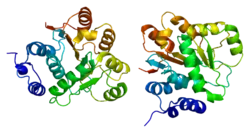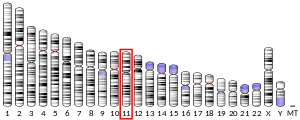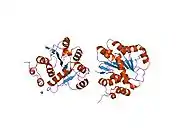| DDX6 | |||||||||||||||||||||||||||||||||||||||||||||||||||
|---|---|---|---|---|---|---|---|---|---|---|---|---|---|---|---|---|---|---|---|---|---|---|---|---|---|---|---|---|---|---|---|---|---|---|---|---|---|---|---|---|---|---|---|---|---|---|---|---|---|---|---|
 | |||||||||||||||||||||||||||||||||||||||||||||||||||
| |||||||||||||||||||||||||||||||||||||||||||||||||||
| Identifiers | |||||||||||||||||||||||||||||||||||||||||||||||||||
| Aliases | DDX6, HLR2, P54, RCK, DEAD-box helicase 6, IDDILF, Rck/p54 | ||||||||||||||||||||||||||||||||||||||||||||||||||
| External IDs | OMIM: 600326 MGI: 104976 HomoloGene: 3238 GeneCards: DDX6 | ||||||||||||||||||||||||||||||||||||||||||||||||||
| |||||||||||||||||||||||||||||||||||||||||||||||||||
| |||||||||||||||||||||||||||||||||||||||||||||||||||
| |||||||||||||||||||||||||||||||||||||||||||||||||||
| |||||||||||||||||||||||||||||||||||||||||||||||||||
| |||||||||||||||||||||||||||||||||||||||||||||||||||
| Wikidata | |||||||||||||||||||||||||||||||||||||||||||||||||||
| |||||||||||||||||||||||||||||||||||||||||||||||||||
Probable ATP-dependent RNA helicase DDX6 is an enzyme that in humans is encoded by the DDX6 gene.[5][6]
DEAD box proteins, characterized by the conserved motif Asp-Glu-Ala-Asp (DEAD), are putative RNA helicases. They are implicated in a number of cellular processes involving alteration of RNA secondary structure such as translation initiation, nuclear and mitochondrial splicing, and ribosome and spliceosome assembly. Based on their distribution patterns, some members of this family are believed to be involved in embryogenesis, spermatogenesis, and cellular growth and division. This gene encodes a DEAD box protein. It may contribute to the cell proliferation and carcinogenesis.[6]
References
- 1 2 3 GRCh38: Ensembl release 89: ENSG00000110367 - Ensembl, May 2017
- 1 2 3 GRCm38: Ensembl release 89: ENSMUSG00000032097 - Ensembl, May 2017
- ↑ "Human PubMed Reference:". National Center for Biotechnology Information, U.S. National Library of Medicine.
- ↑ "Mouse PubMed Reference:". National Center for Biotechnology Information, U.S. National Library of Medicine.
- ↑ Lu D, Yunis JJ (Jun 1992). "Cloning, expression and localization of an RNA helicase gene from a human lymphoid cell line with chromosomal breakpoint 11q23.3". Nucleic Acids Res. 20 (8): 1967–72. doi:10.1093/nar/20.8.1967. PMC 312313. PMID 1579499.
- 1 2 "Entrez Gene: DDX6 DEAD (Asp-Glu-Ala-Asp) box polypeptide 6".
Further reading
- Akao Y, Seto M, Yamamoto K, et al. (1992). "The RCK gene associated with t(11;14) translocation is distinct from the MLL/ALL-1 gene with t(4;11) and t(11;19) translocations". Cancer Res. 52 (21): 6083–7. PMID 1394235.
- Akao Y, Marukawa O, Morikawa H, et al. (1995). "The rck/p54 candidate proto-oncogene product is a 54-kilodalton D-E-A-D box protein differentially expressed in human and mouse tissues". Cancer Res. 55 (15): 3444–9. PMID 7614484.
- Zhang WJ, Wu JY (1996). "Functional properties of p54, a novel SR protein active in constitutive and alternative splicing". Mol. Cell. Biol. 16 (10): 5400–8. doi:10.1128/MCB.16.10.5400. PMC 231539. PMID 8816452.
- Akiyama K, Akao Y, Yokoyama M, et al. (1999). "Expression of two dead box genes (DDX1 and DDX6) is independent of that of MYCN in human neuroblastoma cell lines". Biochem. Mol. Biol. Int. 47 (4): 563–8. doi:10.1080/15216549900201603. PMID 10319407. S2CID 45609314.
- Nakagawa Y, Morikawa H, Hirata I, et al. (1999). "Overexpression of rck/p54, a DEAD box protein, in human colorectal tumours". Br. J. Cancer. 80 (5–6): 914–7. doi:10.1038/sj.bjc.6690441. PMC 2362290. PMID 10360675.
- Smillie DA, Sommerville J (2002). "RNA helicase p54 (DDX6) is a shuttling protein involved in nuclear assembly of stored mRNP particles". J. Cell Sci. 115 (Pt 2): 395–407. doi:10.1242/jcs.115.2.395. PMID 11839790.
- Strausberg RL, Feingold EA, Grouse LH, et al. (2003). "Generation and initial analysis of more than 15,000 full-length human and mouse cDNA sequences". Proc. Natl. Acad. Sci. U.S.A. 99 (26): 16899–903. Bibcode:2002PNAS...9916899M. doi:10.1073/pnas.242603899. PMC 139241. PMID 12477932.
- Miyaji K, Nakagawa Y, Matsumoto K, et al. (2003). "Overexpression of a DEAD box/RNA helicase protein, rck/p54, in human hepatocytes from patients with hepatitis C virus-related chronic hepatitis and its implication in hepatocellular carcinogenesis". J. Viral Hepat. 10 (4): 241–8. doi:10.1046/j.1365-2893.2003.00447.x. PMID 12823589. S2CID 36830183.
- Matsui T, Hogetsu K, Akao Y, et al. (2004). "Crystallization and X-ray analysis of the N-terminal core domain of a tumour-associated human DEAD-box RNA helicase, rck/p54". Acta Crystallogr. D. 60 (Pt 1): 156–9. Bibcode:2004AcCrD..60..156M. doi:10.1107/S0907444903024223. PMID 14684915.
- Ota T, Suzuki Y, Nishikawa T, et al. (2004). "Complete sequencing and characterization of 21,243 full-length human cDNAs". Nat. Genet. 36 (1): 40–5. doi:10.1038/ng1285. PMID 14702039.
- Gerhard DS, Wagner L, Feingold EA, et al. (2004). "The Status, Quality, and Expansion of the NIH Full-Length cDNA Project: The Mammalian Gene Collection (MGC)". Genome Res. 14 (10B): 2121–7. doi:10.1101/gr.2596504. PMC 528928. PMID 15489334.
- Fenger-Grøn M, Fillman C, Norrild B, Lykke-Andersen J (2006). "Multiple processing body factors and the ARE binding protein TTP activate mRNA decapping". Mol. Cell. 20 (6): 905–15. doi:10.1016/j.molcel.2005.10.031. PMID 16364915.
- Matsui T, Hogetsu K, Usukura J, et al. (2006). "Structural insight of human DEAD-box protein rck/p54 into its substrate recognition with conformational changes". Genes Cells. 11 (4): 439–52. doi:10.1111/j.1365-2443.2006.00951.x. PMID 16611246. S2CID 29643976.
- Wichroski MJ, Robb GB, Rana TM (2006). "Human Retroviral Host Restriction Factors APOBEC3G and APOBEC3F Localize to mRNA Processing Bodies". PLOS Pathog. 2 (5): e41. doi:10.1371/journal.ppat.0020041. PMC 1458959. PMID 16699599.
- Chu CY, Rana TM (2006). "Translation Repression in Human Cells by MicroRNA-Induced Gene Silencing Requires RCK/p54". PLOS Biol. 4 (7): e210. doi:10.1371/journal.pbio.0040210. PMC 1475773. PMID 16756390.
- Ewing RM, Chu P, Elisma F, et al. (2007). "Large-scale mapping of human protein–protein interactions by mass spectrometry". Mol. Syst. Biol. 3 (1): 89. doi:10.1038/msb4100134. PMC 1847948. PMID 17353931.
- Nonhoff U, Ralser M, Welzel F, et al. (2007). "Ataxin-2 Interacts with the DEAD/H-Box RNA Helicase DDX6 and Interferes with P-Bodies and Stress Granules". Mol. Biol. Cell. 18 (4): 1385–96. doi:10.1091/mbc.E06-12-1120. PMC 1838996. PMID 17392519.
This article is issued from Wikipedia. The text is licensed under Creative Commons - Attribution - Sharealike. Additional terms may apply for the media files.





